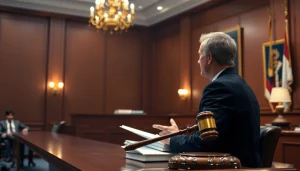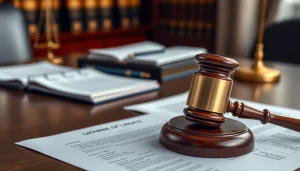
Understanding Mass Tort Marketing
Defining Mass Tort and Its Importance
Mass torts are legal actions where many individuals join together to sue one or a few corporations or entities for damages caused by a common product or course of action. Unlike individual lawsuits, mass torts allow plaintiffs to pool their resources to litigate against large defendants, often leading to significant compensation for the victims. Mass torts typically arise from cases involving pharmaceuticals, defective products, environmental disasters, or medical malpractice. Understanding the nuances of mass torts is crucial for marketing efforts targeting potential clients who may have been affected by such practices.
Key Differences Between Mass Tort and Class Action
While mass torts and class action lawsuits may seem similar, there are key differences that set them apart. In a class action, a group of people with common claims is represented by one or two individuals (the class representatives) who act on behalf of all members. The outcome affects all class members equally. Conversely, in a mass tort case, every claimant maintains their individual claim and can receive varying amounts of compensation based on their unique circumstances. This distinction is vital as mass tort marketing strategies must address the individual narratives of potential clients while emphasizing the collective power of seeking justice together.
The Role of Marketing in Mass Tort Litigation
Effective marketing is crucial for attorneys and firms engaged in mass tort litigation. With the complexities involved, compelling marketing campaigns help raise awareness about potential claims and drive clients to legal representation. Marketing strategies may involve comprehensive online campaigns, community outreach, and traditional advertising, all aimed at educating victims about their rights and the possibility of restitution. Mass Tort Marketing encompasses these efforts, focusing on connecting those in need of legal assistance with firms ready to pursue justice on their behalf.
Target Audience Identification in Mass Tort Marketing
Researching Demographics and Psychographics
To effectively reach potential clients, robust research into both demographics and psychographics is imperative. Demographics provide information such as age, gender, income, occupation, and education level, while psychographics delve deeper into personality traits, interests, values, and lifestyles. Understanding these aspects allows firms to tailor their messaging to resonate with the emotional and practical concerns of affected individuals. For instance, victims of a defective medical product may have a higher likelihood of responding to messages that offer empathetic understanding and highlight the harmful consequences they faced.
Creating Client Personas for Effective Messaging
Once a firm has gathered demographic and psychographic data, creating detailed client personas is the next step. A client persona is a semi-fictional representation of the ideal client, crafted from the data collected. This persona should encapsulate the typical characteristics of potential claimants, illuminating their pain points, motivations, expectations, and preferred communication channels. For example, a persona may illustrate a middle-aged woman aware of recent lawsuits against a harmful drug, expressing anxiety over her family’s health. This insight enables marketers to fine-tune social media campaigns, blog content, and email outreach that speak directly to that audience’s concerns and encourage them to seek legal help.
Utilizing Data Analytics to Guide Targeting Efforts
Data analytics plays a critical role in not only understanding potential clients but also measuring the effectiveness of marketing initiatives. By analyzing patterns in web traffic, social media engagement, and client responses, firms can discern which marketing channels yield the best outcomes and adjust their strategies accordingly. Tools such as Google Analytics, social media insights, and customer relationship management (CRM) systems provide actionable data that inform decisions on audience segmentation, budget allocations, and messaging effectiveness. Firms can optimize their outreach efforts, ensuring they reach the most relevant potential clients with the right messages at the right time.
Best Practices for Mass Tort Marketing Campaigns
Leveraging Digital Marketing Channels
Digital marketing is particularly effective for mass tort campaigns, as it allows for widespread outreach at a fraction of the cost of traditional marketing methods. Tactics to consider include search engine optimization (SEO), pay-per-click (PPC) advertising, and email marketing. SEO involves optimizing website content to rank higher on search engine results, allowing potential clients searching for related legal services to discover the firm organically. PPC can generate immediate traffic; however, it requires careful targeting to ensure that ads reach those most likely to need representation.
Effective Use of Social Media for Client Engagement
Social media platforms present an ideal venue for firms to engage with potential clients directly. Utilizing platforms like Facebook, Instagram, and LinkedIn, attorneys can share informative content, client testimonials, and updates about ongoing cases to foster a community and build trust with potential clients. Additionally, social media advertising enables precise targeting settings that can reach specific demographics, further enhancing outreach effectiveness. Interaction through Q&A sessions or live videos can also humanize the firm’s approach, making legal professionals seem more approachable and trustworthy.
Content Marketing Strategies for Increased Awareness
Content marketing is indispensable in mass tort marketing as it focuses on creating valuable, informative content that addresses the concerns and questions of potential clients. Blog posts, whitepapers, and educational videos can dissect complex legal topics, providing clarity and guidance. Informational pieces about specific mass tort cases or the legal process can position the firm as a thought leader, instilling confidence in potential clients. Additionally, leveraging SEO best practices in content can ensure that materials rank well in search engines, driving organic traffic to the firm’s site.
Measuring Success in Mass Tort Marketing
Key Performance Indicators to Track
Evaluating the success of marketing campaigns is vital for continuous improvement. Key performance indicators (KPIs) such as website traffic, conversion rates, lead generation, and engagement metrics (likes, shares, comments, etc.) can yield insights into what is working and what needs adjustment. Additionally, tracking the cost-per-lead and return on investment (ROI) for various campaigns informs budget allocation and strategic planning, allowing firms to pivot resources toward the most effective tactics.
Using Client Feedback for Continuous Improvement
Client feedback plays a crucial role in enhancing mass tort marketing efforts. Soliciting feedback through surveys, follow-up emails, or informal conversations can provide insights into client experience from initial contact to litigation. Understanding what aspects of the marketing resonated with clients can inform future campaigns and help refine messaging to better meet the audience’s needs. This approach not only optimizes marketing efforts but fosters a culture of client-centric service that positions the firm for success.
Case Studies of Successful Mass Tort Marketing Efforts
Analyzing case studies of successful mass tort marketing campaigns can provide a wealth of information on best practices. For instance, one prominent law firm successfully utilized a targeted social media campaign to increase engagement among potential clients affected by a widely publicized pharmaceutical issue. By leveraging powerful storytelling that highlighted individual plaintiff narratives, they resonated emotionally with their audience. This approach yielded a significant increase in inquiries, showcasing how strategic messaging can not only attract clients but also foster community awareness around mass tort cases.
Future Trends in Mass Tort Marketing
Emerging Technologies and Their Impact on Marketing
The landscape of mass tort marketing is evolving rapidly due to technological advancements. Artificial intelligence (AI) and machine learning facilitate improved data analysis, allowing firms to deepen their understanding of audience behavior and preferences. Chatbots and automated customer service platforms can enhance engagement and response times, ensuring potential clients receive timely support. Additionally, virtual reality (VR) and augmented reality (AR) might be leveraged to create awareness campaigns that vividly showcase the consequences of mass tort cases, making the information more relatable and impactful.
Adjusting Strategies to Changing Legal Environments
The legal landscape is in constant flux, influenced by legislative changes, court rulings, and shifting public opinion. Mass tort marketers must be agile, adapting their strategies in response to these changes. Staying informed about industry news, legislative developments, and the regulatory environment surrounding mass torts helps firms navigate challenges effectively. This adaptive approach not only preserves a firm’s reputation but also ensures its marketing efforts remain relevant and effective in engaging potential clients amid ongoing legal evolution.
The Importance of Ethical Marketing in Mass Tort Cases
Ethical considerations must underpin all mass tort marketing efforts. Transparency and truthfulness in communication are paramount to maintain trust with potential clients. Misleading advertisements or exaggerated claims can not only harm a firm’s reputation but can lead to potential legal repercussions. Ethical marketing practices involve clear disclaimers, straightforward information about the litigation process, and genuine support for clients willing to enter legal battles. Upholding integrity in mass tort marketing fosters long-term relationships and creates a foundation of trust that is essential in the legal profession.






